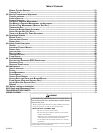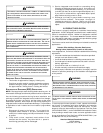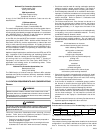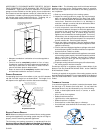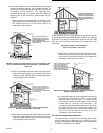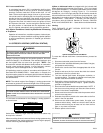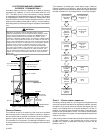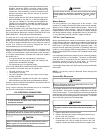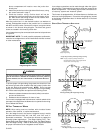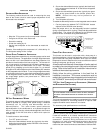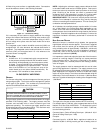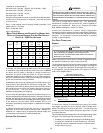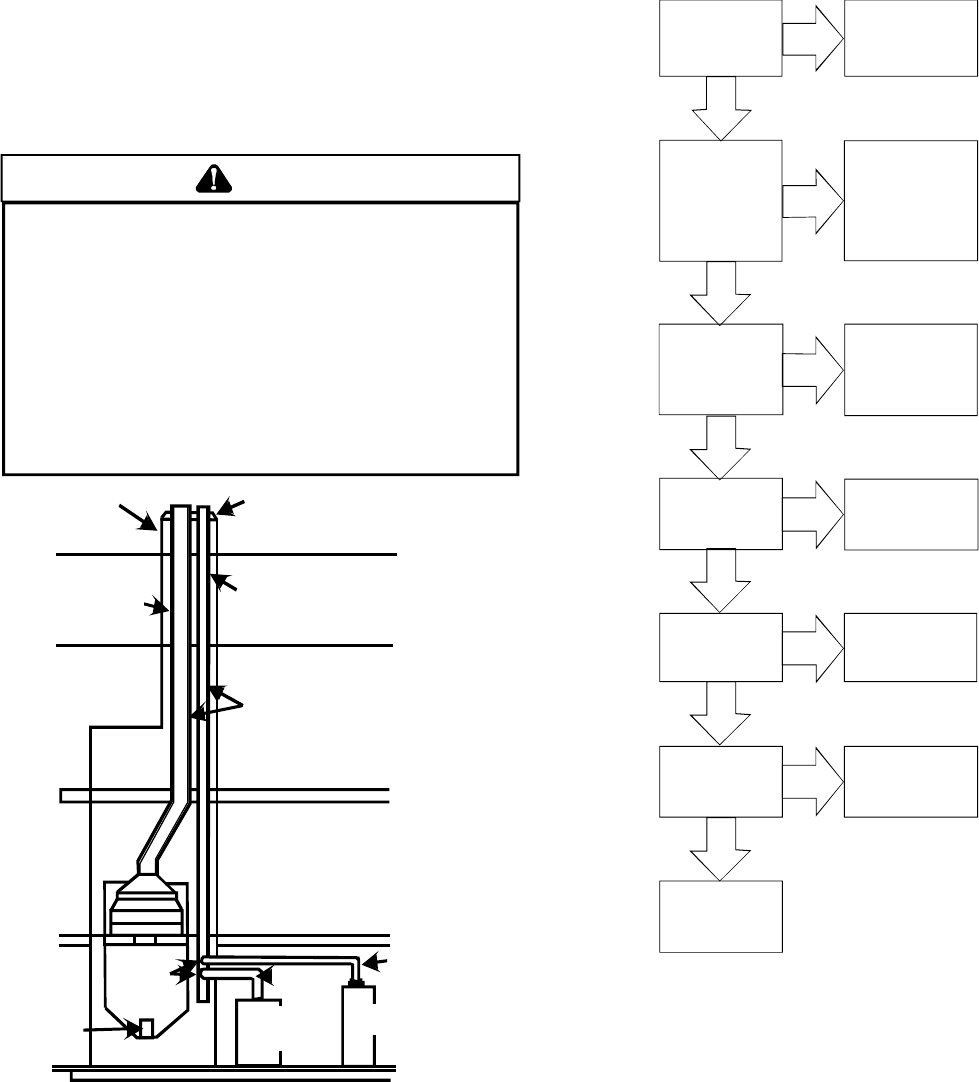
11
IO-247A 12/04
VII. EXTERIOR MASONRY CHIMNEYS -
CATEGORY I FURNACES ONLY
An exterior masonry chimney is defined as a “Masonry chimney
exposed to the outdoors on one or more sides below the roof
line.” The ability to use a clay lined masonry chimney depends
on a parameter not associated with interior chimneys. This variable
is the geographic location of the installation. Researchers have
discovered that the winter design temperatures have a direct
impact on the suitability of this type of venting. In most situations,
the existing masonry chimneys will require a properly sized metallic
liner.
WARNING
P
OSSIBILITY OF PROPERTY DAMAGE, PERSONAL INJURY OR DEATH
DAMAGING CONDENSATION CAN OCCUR INSIDE MASONRY CHIMNEYS WHEN A
SINGLE FAN ASSISTED
C
ATEGORY
I
APPLIANCE (80%
AFUE
FURNACE) IS
VENTED WITHOUT ADEQUATE DILUTION AIR.
D
O NOT CONNECT AN 80%
FURNACE TO A MASONRY CHIMNEY UNLESS THE FURNACE IS COMMON VENTED
WITH A DRAFT HOOD EQUIPPED APPLIANCE OR THE CHIMNEY IS LINED WITH A
METAL LINER OR
T
YPE
B
METAL VENT.
A
LL INSTALLATIONS USING MASONRY
CHIMNEYS MUST BE SIZED IN ACCORDANCE WITH THE APPROPRIATE VENTING
TABLES.
I
F AN 80% FURNACE IS COMMON VENTED WITH A DRAFT HOOD
EQUIPPED APPLIANCE, THE POTENTIAL FOR CONDENSATION DAMAGE MAY
STILL EXIST WITH EXTREMELY COLD CONDITIONS, LONG VENT CONNECTORS,
EXTERIOR CHIMNEYS, OR ANY COMBINATION OF THESE CONDITIONS.
T
HE
RISK OF CONDENSATION DAMAGE IS BEST AVOIDED BY USING THE MASONRY
CHIMNEY AS A PATHWAY FOR PROPERLY SIZED METAL LINER OR
T
YPE
B
METAL VENT.
Wash
Crown
Clay Tile Size: 8" x 8" x12"
(Each x 24" Length)
Clay Tile Size Generally
12" x 12" (24" Length)
1/2" to 1" Air Space
Second Floor
First Floor
Attic Floor
Roof Line
Throat
Damper
Breech
Clean Out
Fan Assisted
Forced Air
Furnace
Natural Draft
Water Heater
Water Heater
Vent Connector
Basement Floor
F.A.F. Vent
Connector
Figure 8 - Typical Multiple Flue Clay Tile Chimney
CHECKLIST SUMMARY
This checklist serves as a summary of the items to be checked
before venting an 80+ furnace into a masonry chimney. In addition,
we recommend that a qualified serviceman use this checklist to
perform a yearly inspection of the furnace venting system.
This checklist is only a summary. For detailed information on each
of the procedures mentioned, see the paragraph referenced with
each item.
This inspection is based upon a draft topical report, “Masonry
Chimney Inspection and Relining”, issued by the Gas Research
Institute. While not yet finalized, we believe this report represents
the best information on this subject which is currently available.
Proper Chimney
Termination?
(Check 1)
Line, terminate with
listed vent cap
(Fix 1)
No
Yes
Chimney channel
free of solid and
liquid fuel
appliances?
(Check 2)
Change venting
arrangements
(Fix 2)
No
Yes
Crown in good
condition
(Check 3)
Rebuild crown
(Fix 3)
and/or Reline
(Fix 4)
Yes
No
Yes
No
No
Reline
(Fix 4)
Reline
(Fix 4)
Cleanout free of
debris?
(Check 4)
Liner in good
condition?
(Check 5)
Yes
Yes
No
Reline
(Fix 4)
Dilution air
available?
(Check 6)
Complete the
installation.
(Check 7)
CHECK 1 - PROPER CHIMNEY TERMINATION.
A masonry chimney used as a vent for gas fired equipment must
extend at least three feet above the highest point where it passes
through the roof. It must extend at least two feet higher than any
portion of a building within a horizontal distance of 10 feet. In
addition, the chimney must terminate at least 3 feet above any
forced air inlet located within 10 feet. The chimney must extend at
least five feet above the highest connected equipment draft hood
outlet or flue collar.
If the chimney does not meet these termination requirements, but
all other requirements in the checklist can be met, it may be
possible for a mason to extend the chimney. If this will not be
practical, see Fix 1.



